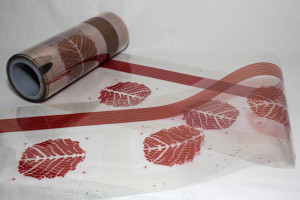
Design freedom improves the range of applications of the panels on the surfaces of interior and exterior building spaces.
Image: Antti Veijola
We’ve been talking about climate change and green energy for a while now, so of course we think solar panels should exist wherever light is. Now, that could mean using solar wallpaper to harvest as much energy as possible.
VTT Technical Research Centre of Finland has developed and utilized a mass production method based on printing technologies that will allow the manufacturing of decorative, organic solar panels for use on the surfaces of interior and exterior building spaces.
The new organic photovoltaic panels are only 0.2 mm thick each and include the electrodes and polymer layers where the light is collected.
This from VTT Technical Research Centre of Finland:
The research scientists have tested the feasibility of the method by printing leaf-shaped photovoltaic cells. Active surface of a one leaf is 0.0144 m² and includes connections and a decorative part. Two hundred OPV leaves make one square metre of active solar panel surface that generates 3.2 amperes of electricity with 10.4 watts of power at Mediterranean latitudes.
However, organic panels tend to be more expensive and less efficient than inorganic solar panels, which are generally made from silicon. The company is addressing this issue by beginning to explore the feasibility of printing technology in the mass production of solar panels made from the more efficient inorganic perovskite materials.
[Source: IEEE Spectrum]Get involved in the solar conversation! Join us at the ECS Conference on Electrochemical Energy Conversion & Storage with SOFC-XIV in Glasgow this July!
The lead organizers of this conference are among the top researchers in their respective fields. Meet them here.
(P.S. Abstracts for this meeting are due by February 20, 2015. Find out more about submitting your abstract today!)


